In the Moment:
Michael Frye's Landscape Photography Blog
by Michael Frye | Dec 18, 2013 | Announcements, Vision and Creativity
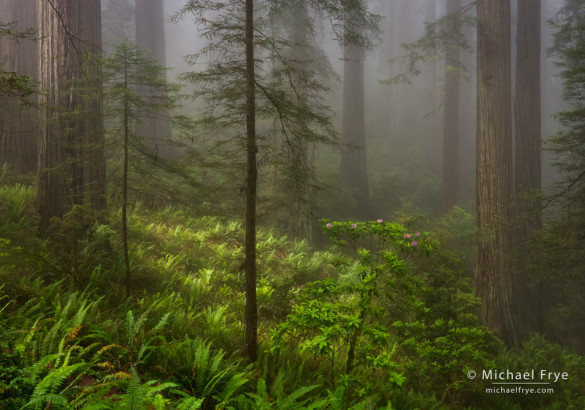
Redwoods, ferns, and rhododendrons near the northern California coast, USA
Continuing our look at back at the most popular posts of 2013, here’s one that’s been extremely popular – in fact it’s my most-read post ever. It’s from January 2013, and it’s called Creating Depth: Beyond the Wide-Angle Formula.
This post looks at some alternatives to the popular, wide-angle, near-far look that you see in so many landscape photographs – alternatives like atmospheric effects, subtle perspective clues, and size comparisons. And the article also explains why many photographs and paintings with a sense of depth have something in common that’s not immediately obvious.
To all of you who read this article, commented, or wrote me an email response, thanks very much! Your participation makes writing this blog fun, and I know your comments make reading it more enjoyable for everyone.
— Michael Frye
Michael Frye is a professional photographer specializing in landscapes and nature. He is the author or principal photographer of The Photographer’s Guide to Yosemite, Yosemite Meditations, Yosemite Meditations for Women, and Digital Landscape Photography: In the Footsteps of Ansel Adams and the Great Masters. He has also written three eBooks: Light & Land: Landscapes in the Digital Darkroom, Exposure for Outdoor Photography, and Landscapes in Lightroom 5: The Essential Step-by-Step Guide. Michael written numerous magazine articles on the art and technique of photography, and his images have been published in over thirty countries around the world. Michael has lived either in or near Yosemite National Park since 1983, currently residing just outside the park in Mariposa, California.
by Michael Frye | Dec 1, 2013 | Vision and Creativity
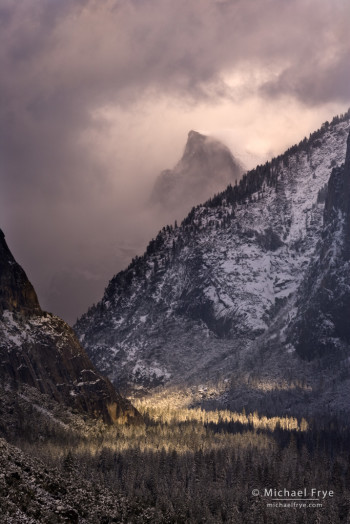
Half Dome and Yosemite Valley from Tunnel View, Yosemite NP, CA, USA
In a recent post I talked about adapting your composition to the light, rather than hoping that the light adapts to your composition. Nowhere is this more true than at Tunnel View. Sometimes the classic view – with El Capitan on the left, and Cathedral Rocks on the right – works perfectly. But not always. When I made this photograph the most interesting part of the scene was a small area in the distance where the light was hitting Half Dome and the valley floor below, so I zoomed in with my 70-200mm lens, turned the camera to a vertical orientation, and filled the frame with just those two spots.
Looking at this photograph made me think about clearing storms, and snow, and Christmas coming. I hope we get lots of snow this winter, not just for the sake of photographers, but for everyone in California. We’ve had two straight years of meager precipitation here, and we really need a wet winter. So let it snow!
— Michael Frye
Related Posts: Courting Luck: How to Take Advantage of Special Light and Weather in Landscape Photography; Courting Luck, Part 2: Adapting Your Composition to the Conditions; A Beautiful Week in Yosemite
Did you like this article? Click here to subscribe to this blog and get every new post delivered right to your inbox!
Michael Frye is a professional photographer specializing in landscapes and nature. He is the author or principal photographer of The Photographer’s Guide to Yosemite, Yosemite Meditations, Yosemite Meditations for Women, and Digital Landscape Photography: In the Footsteps of Ansel Adams and the Great Masters. He has also written three eBooks: Light & Land: Landscapes in the Digital Darkroom, Exposure for Outdoor Photography, and Landscapes in Lightroom 5: The Essential Step-by-Step Guide. Michael written numerous magazine articles on the art and technique of photography, and his images have been published in over thirty countries around the world. Michael has lived either in or near Yosemite National Park since 1983, currently residing just outside the park in Mariposa, California.
by Michael Frye | Nov 26, 2013 | Composition, Photography Tips, Vision and Creativity
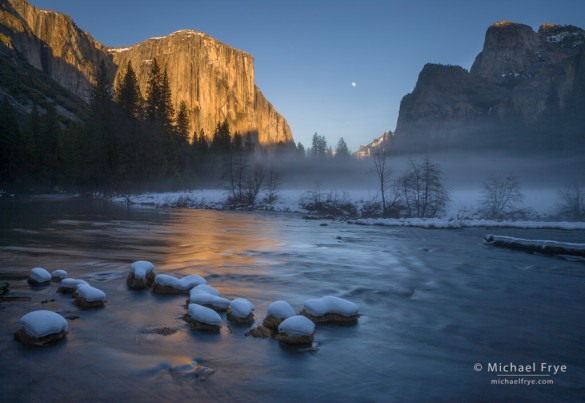
Moon rising between El Capitan and Cathedral Rocks from Valley View. What’s the least interesting part of this image?
The best compositions are simple; they present only the essentials, and leave out extraneous clutter. The most common mistake in photography – by far – is including too much in the frame. Anything that’s not adding to the photograph’s message is detracting from it.
To help simplify your compositions, ask yourself, before you press the shutter, “What’s the least interesting part of this photograph?” Try to identify the weakest area of your composition, and find a way to get rid of it. Then, once you’ve done that, ask the same question again: “Now, what’s the least interesting part of this image?” And get rid of that. And keep doing that until there’s nothing left that you could possibly cut out without losing something vital.
To give you some practice, look at the photograph above. What’s the least interesting part of that image? And if you got rid of that, what would be next – what’s the next least interesting part of the photograph?
I’ll give you a minute to think about it. When you’re ready, take a look at this next photograph, and answer the same question: what’s the least interesting part of this image?
(more…)
by Michael Frye | Nov 19, 2013 | Composition, Photography Tips, Vision and Creativity
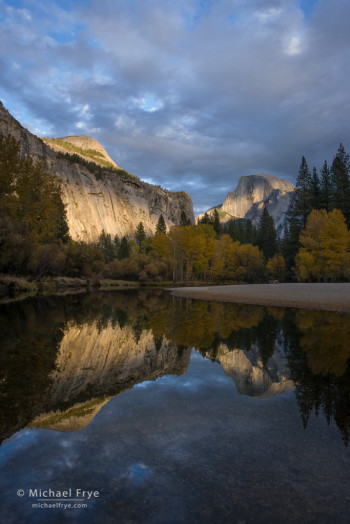
Half Dome and the Merced River, 4:28 p.m.
Is it better to be active or static? To change your location and composition to suit the light, or hope that the light changes to suit your composition?
There’s this persistent myth that Ansel Adams would camp for days at one spot, waiting for the right light. Ironically, this myth is often repeated in relation to Clearing Winter Storm, which was made at Tunnel View, only a few miles from his warm home and comfortable bed in Yosemite Valley. In fact Ansel wrote, “I have always been mindful of Edward Weston’s remark, ‘If I wait for something here I may lose something better over there.’ I have found that keeping on the move is generally more rewarding.”
I have also found that keeping on the move is more rewarding. I’ve sometimes regretted moving, but more often regretted staying when I ignored the inner voice that told me the light would be better elsewhere. And when I do find myself in the right place at the right time, I’ve found that it pays to stay active with my camera and my compositions, and not get lazy about changing lenses or camera positions. If I decide in advance what my composition should be, and stick with that no matter what, I’ll probably miss some great opportunities.
(more…)
by Michael Frye | Oct 13, 2013 | Photography Tips
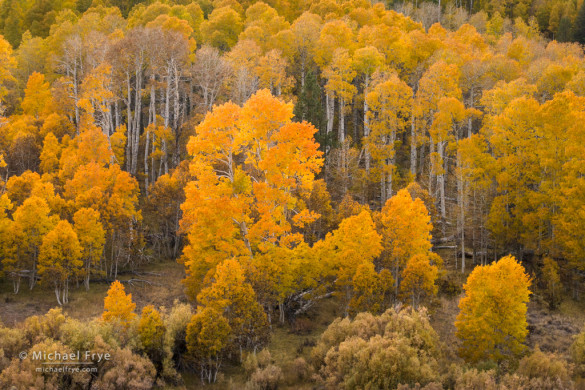
Autumn aspens, Conway Summit, Inyo NF, CA, USA
Here are two photographs I made last week near Conway Summit on the eastern side of the Sierra. The first one, above, is from Tuesday afternoon, with soft backlight filtering through thin clouds and making the leaves glow. The second image, below, was made Wednesday morning under overcast skies as the snow started to fall. I used a fast shutter speed (1/90th sec.) to freeze the motion of the snowflakes, which created a faint white dot pattern across the frame.
(more…)













